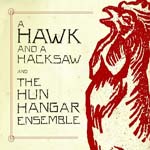
A Hawk and A Hacksaw
A Hawk and A Hacksaw and the Hun Hangár EP
(Leaf; 2007)
By Philip Guppy | 30 November 2007
The EP as an entity still holds for many an air of experimentalism. Its place in the annals of alternative rock is secured by way of its adoption as the format of choice for tentative steps, as a silver bullet for bringing down the spectre of a fresh idea. Despite being created to allow bands to release a smaller number of tracks than an LP in the interim between albums, it's been grasped in indie circles as a badge of honour; seen as a way to state allegiance to the grand traditions of the high church of independent rock. It stands diminutive, yet crucial alongside the double album and the rock Holy Grail, the triple album, as a format of choice for the indie connoisseur looking to nail their colours to the mast. Bands such as The Cocteau Twins and Stereolab bestowed upon the EP the same reverence as the long player, utilising its brief running time to dabble and create perfect posies, small collections which stand alone as powder pockets between the larger statements. In the right hands they become potent and substantial, a test in focus for the band, an aural haiku that stands or falls within the constraints of four to eight tracks.
A Hawk and a Hacksaw take up the EP challenge with their new release, a collection of tracks that takes their previous interest with the music of the Balkans and Eastern Europe in one hand and dives directly to the source. Joining forces with The Hun Hangár Ensemble, a collective that runs pure with the blood of Hungarian folk, they have achieved a state of immersion that places them directly within the grand tradition rather than blindly launching volleys from the walls of approximation. Melancholy and flailing in equal parts, these songs resonate with history and bring to mind the sounds of a life tied to the earth and the calls of wild starlit abandon. Walls are constructed, seasons pass and armies march ever onward; marriages are consummated and families pass from generation to generation, all under the auspices of wild strains of folk that signal the ages like whirling wordless dervishes.
I have to confess I don't have the first clue about the meaning of most the song titles. As far as I've been able to discern a "Hora" refers to a kind of circle dance, which would detail the two Hora songs well. "Romanian Hora and Bulgar" betrays a feeling of request and graceful acceptance, before launching into a frenzied, carnal lashing of limbs and stamping of feet; music and dancing as a sexual prelude. The "Oriental Hora" is much more sedate, choosing a mournful swaying melody; a slow dance that still manages to swarm with a surfeit of sexual energy, its participants taking the time to discern the heart before consenting to the act. Centrally employing the violin and cybalom (a traditional dulcimer-type instrument) alongside instruments such as the upright bass and clarinet, the songs collected here give a sense of a proud musical heritage, a world contained within a web of tradition. The sound of bagpipes on the final song, "Dudanotak," comes as a surprise, linking the song mentally to the Celtic traditions of Scotland. The sound echoing out across the landscape like a rallying cry, before a drum tattoo provides a central standing stone and allows the pipes to dip and waver in another poised, dancing display.
Undoubtedly this is music with an age-old heart, music for the crowd, music to celebrate the now and usher in the breath of life, dripping with marvel and purpose. How close this is to the traditions and sounds of actual Hungarian folk I couldn't tell you, however it strikes like a hammer on hot iron, with no pretence, no betrayal or quarter given to the sounds of Hawk and a Hacksaw's home country. Authenticity seems ingrained in its grooves, unlike the feeling of adoption that haunted Beirut's otherwise excellent _Gulag Orkestar_ (2006). As an EP that serves as an introduction for Western audiences to the sounds of Hungarian folk music, it exists under a European sky in swathes of ceremony and function, waiting to be uncovered, like a statue still half in the stone.





